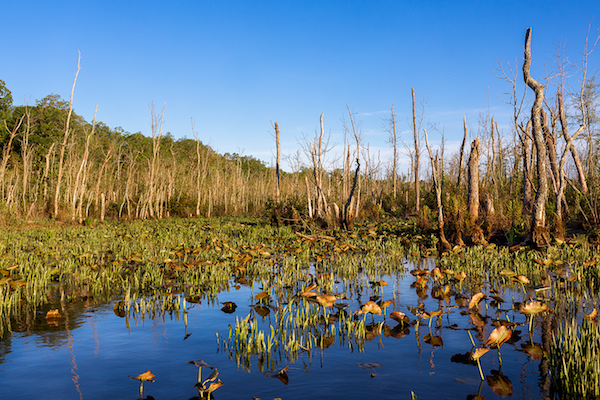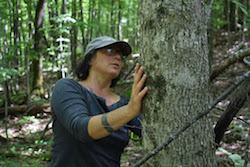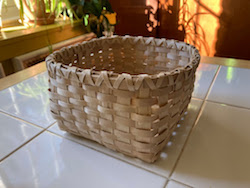SEJournal Online is the digital news magazine of the Society of Environmental Journalists. Learn more about SEJournal Online, including submission, subscription and advertising information.
 |
| Throughout North America, an invasive pest has devastated the ash tree, which is ecologically important and is also used by Indigenous communities for the age-old practice of basket making. Above, a dead ash grove at Mattawoman Creek in Maryland. Photo: Leslie Brice. |
FEJ StoryLog: Determined Grantee Weaves Together Unique Project on Ash Trees, Wetlands and Baskets
By Gabriel Popkin
For years, I have reported on the emerald ash borer, an invasive pest native to Asia that has devastated hundreds of millions of ash trees throughout North America. In early 2019, I decided to revisit the topic for a different kind of story: I wanted to focus on the threat that the wood-boring beetle poses to the vast strongholds of ash trees in northerly areas stretching from Minnesota to Maine — and to the region’s Indigenous communities.
The black ash species is ecologically vital for the region’s swamps and wetlands. It is equally vital for a centuries-old practice of basket making. The tribal communities that developed this practice are now leading efforts to preserve and protect ash forests on their lands.
I envisioned a story connecting
this biodiversity crisis to the lives
and concerns of actual people.
I envisioned a story connecting this biodiversity crisis to the lives and concerns of actual people that would clearly show human costs when important native trees are wiped out.
It felt like one of the biggest untold biodiversity stories in my part of the world.
The Society of Environmental Journalists’ 2019 call for biodiversity-themed Fund for Environmental Journalism proposals seemed like a perfect fit, and my application was rewarded with a generous grant covering both travel and time to work on the story.
Lessons in basket making
Almost as soon as I got the grant, I took off for the woods of northern Minnesota for the first of what ended up being three trips (and counting).
I attended a basket-making workshop on the reservation of the Fond Du Lac Band of Lake Superior Chippewa, west of Duluth. The workshop was led by April Stone, a largely self-taught basket maker from the nearby Bad River Band of Lake Superior Chippewa in northwest Wisconsin.
 |
| April Stone, above, inspecting a black ash tree near her house in northwest Wisconsin. Photo: Gabriel Popkin. |
It was fascinating to follow Stone into a remote swamp and watch her select a perfect tree, offer a prayer and a gift of tobacco and haul it out of the woods after one of the tribal members felled it with a chainsaw.
For all we hear and read about logging and forest destruction, this felt like a respectful ritual that involved taking from the forest only what was needed. I later learned that Indigenous researchers have found that black ash forests actually grow better when trees are harvested by basket makers.
At the workshop, I started weaving my first-ever basket. I was struck by two things. One was how just one tree furnished everything we needed for our baskets. Indeed, in the Ojibwe language, ash is called agimaak, which means “bending wood.”
The other was how unskilled I was with the material. When I tried to imitate Stone’s deft motions, the ash strips that were so compliant and workable in her hands rebelled at my clumsy efforts.
Stone turned out to be a charismatic storyteller and teacher with cool tattoos and an unorthodox way of thinking about emerald ash borer. I quickly realized she was the strongest character around whom to build my story.
I made a second trip later that summer to spend more time with her at her home near Ashland and Gichigami (Lake Superior in Ojibwe). Even so, I realized a third trip would be needed to fully report out the story and immerse myself in the complex Indigenous culture of the region, which I hoped to get funded by whichever outlet ended up commissioning my idea.
Other work, pandemic stall project
Back home, I set to work on a pitch, but other assignments got in the way, and truth be told, I also probably got in my own way. I felt so passionately about the story and making sure I told it right that I spent too much time trying to perfect the pitch.
With COVID-19 consuming so much of
everyone’s bandwidth, getting editors to
focus on a biodiversity story seemed daunting.
Then the COVID-19 pandemic hit, making additional reporting trips nearly impossible. And with COVID-19 consuming so much of everyone’s bandwidth, getting editors to focus on a biodiversity story seemed daunting. So I put the project on hold.
I kept in touch with Stone through occasional texts and emails to assure her I was still interested in doing the story. Once I felt that travel was possible again, I began pitching.
I have since pitched versions of the story to at least a half-dozen editors. Some pitches emphasized threats to the biodiversity and ecosystem services of ash-dominated wetlands; others focused more on basketry and the human story embodied by Stone.
Only one outlet accepted my pitch; it proposed an online piece with no compensation, which I declined on principle. Several other editors seemed interested but were unable to get superiors to greenlight the story, sometimes for reasons that seemed to have little to do with its merits. It has been a frustrating experience.
New storytelling options surface
Meanwhile, the pandemic helped open up another avenue to document the emerald ash borer’s impact on biodiversity.
In fall 2019, a local photographer and good friend, Leslie Brice, and I went canoeing on Mattawoman Creek, a tributary of the Potomac River in Maryland south of Washington, D.C. Rounding a bend, we found ourselves staring at huge groves of dead ash trees. It looked like a bomb had gone off.
I had not realized there were large ash-dominated wetlands similar to the ones I had been exploring in the Midwest practically in my backyard.
I later learned that the mid-Atlantic wetlands were anchored by green and pumpkin ash, not black ash, but the tree’s foundational role in the ecosystem is very similar.
Just as the COVID-19 shutdowns started in spring 2020, Leslie and I began following ecologists studying ash wetlands on the west side of the Chesapeake Bay, where the ash borer had already killed trees, and on the Eastern Shore, where trees were mostly still alive.
With most travel temporarily on hold, the reduced traffic on the roads made it easy to visit local research sites. We were able to closely observe the scientists as they studied how the wetlands were responding and whether other types of trees could take the ash’s place. A guest essay based on our reporting ran in February 2022 in The New York Times (may require subscription).
The Ash Forest Project
This past August, with the pandemic receding, Leslie and I went back to Wisconsin (using the last of my FEJ travel grant and my own funding) to meet with Angela Waupochick, a forest ecologist and member of the Menominee Nation in Wisconsin, which owns and manages a world-famous forest that includes a number of black ash wetlands.
Most remain healthy, vibrant and ecologically diverse so far, but at one site, the emerald ash borer landed a couple of years ago and trees are already in decline. Waupochick has wired up trees in wetlands on her tribe’s land to study the ash borer’s impact on forest hydrology. We published essays on some of the material we gathered.
We formalized our efforts into something
we call the Ash Forest Project, hired a
photographer to capture aerial imagery,
and created a website and exhibition.
Leslie and I eventually formalized our efforts into something we call the Ash Forest Project. We hired a talented drone photographer to capture aerial imagery that gives a sense of the geographic scale of the threatened ecosystems. We created a website and a physical exhibition featuring photos from Maryland and Wisconsin alongside my text at Joe’s Movement Emporium, a dance, theater and exhibition space in Mount Rainier, Maryland, where we both live.
On November 6 and January 8, we hosted receptions attended by an estimated 125 people, at which we presented our work. Some scientists we’ve been following also spoke about their work protecting and restoring ash wetlands.
Because people come to Joe’s every day for dance classes, workshops and events, our work has been seen by hundreds if not thousands of people and will reach many more, as the exhibition remains up indefinitely.
We have also created a virtual exhibition. Several local reporters and filmmakers have expressed interest in the project, which may lead to additional media coverage and reach. The University of Maryland covered the project in two of its publications.
And on January 11 I had an opportunity to present the project to around 200 attendees at the U.S Department of Agriculture Interagency Forum on Invasive Species in Annapolis.
A visuals-first storytelling technique
The Ash Forest Project has been a major departure from my usual work.
For one thing, it has been driven less by news value considerations than by Leslie’s and my own interest and passion. The project also has a documentary flavor and a bit of an advocacy feel, not in the sense that we are pushing a particular solution or policy response, but rather in that we are consciously trying to get people to pay attention to an environmental disaster and to how our globalized economy has essentially invited one pest after another to tear through our woods.
We chose a visuals-first storytelling
treatment, with text subsidiary to the
images rather than the other way around.
We chose a visuals-first storytelling treatment, with text subsidiary to the images rather than the other way around. It is by far the most intense and longest-lasting collaboration I have ever undertaken with a photographer, and I’m grateful Leslie and I have remained friends through the whole thing.
Despite the challenges, it has been a highly enjoyable learning experience, and it probably would not have happened without the FEJ grant that got me started on reporting on the emerald ash borer and wetlands.
It also probably would not have happened without the pandemic, which opened up space for me to immerse myself in a local story for far longer than typical journalistic calculations would have allowed.
All that said, I have not abandoned my original story idea. In fact, I feel as strongly as ever that it is a vital story to tell.
This past summer, on the way to visit Waupochick, I drove back to Stone’s house and hung out with her for a couple more days, in part to get my head back into the story after a three-year reporting hiatus, and in part to enlist her help in finishing my basket. While it pales in comparison to the impressive works Stone creates, I have to admit, I’m kind of proud of it!
 |
| The author’s modest attempt at a black ash basket, with assistance from April Stone. Photo: Gabriel Popkin. |
After years of trying to pitch this as a biodiversity-first story, I am now focusing on ash basket making as a unique, Indigenous American art form threatened by the emerald ash borer.
While the ecology of swamps fascinates me, I have come to recognize it can be a tough sell beyond a niche market of environment-themed publications; indeed, at least one of my pitches was turned down by an editor who felt it was too thematically similar to the Times essay.
By focusing instead on baskets and basket makers, I think I can offer a fresh, human-centered story with potential “crossover” appeal to editors at general interest outlets. If that editor might be you, please get in touch — I have got a great story.
Gabriel Popkin is an award-winning science and environmental journalist who writes often about trees, forests and invasive species. He has written for The New York Times, Science, Washington Post, National Geographic and many other outlets. He also recently contributed a story to SEJournal on how satellite data helps identify tensions between food production and biodiversity. Popkin lives in Mount Rainier, Maryland, just outside the nation's capital.
For more on this story, click the short video below for aerial photography of Maryland ash forests along Tuckahoe Creek, Nanticoke River, Marshyhope Creek and Mattawoman Creek.
* From the weekly news magazine SEJournal Online, Vol. 8, No. 4. Content from each new issue of SEJournal Online is available to the public via the SEJournal Online main page. Subscribe to the e-newsletter here. And see past issues of the SEJournal archived here.













 Advertisement
Advertisement 



